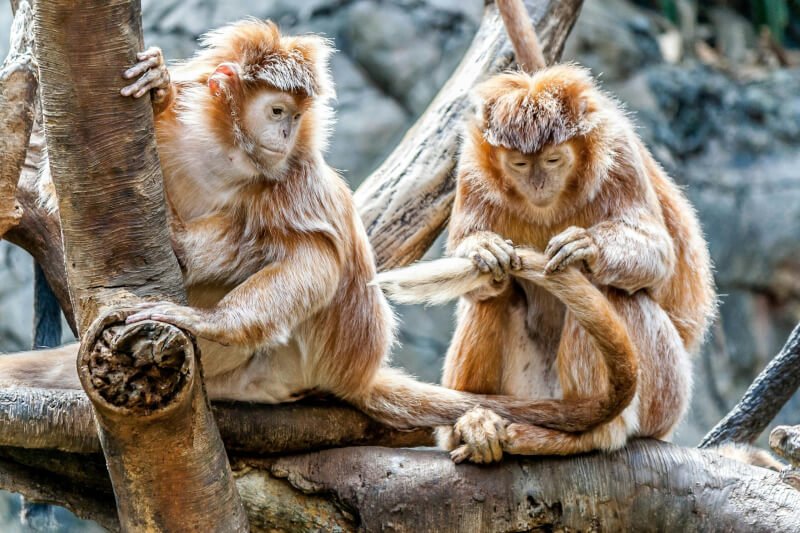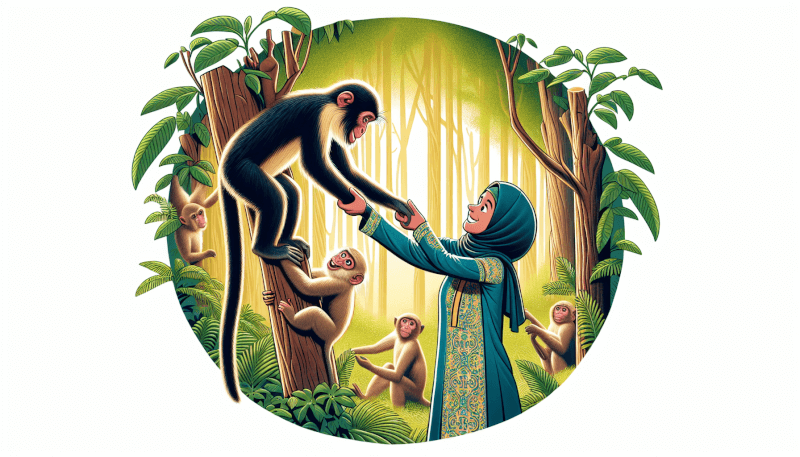In the world of primate rehabilitation, fostering empathy and cooperation among the animals is key to their successful reintegration into the wild. Primate rehabilitation programs aim to provide a safe and nurturing environment for primates who have been orphaned, injured, or rescued from the illegal pet trade. By promoting empathy and cooperation, these programs not only help the primates heal physically but also aid in their emotional and social development. This article explores the strategies and techniques employed by primate rehabilitation programs to encourage empathy and cooperation, highlighting their importance in the overall well-being and future of these remarkable creatures.

Understanding Primate Rehabilitation
Primate rehabilitation programs play a significant role in the conservation and welfare of these incredible creatures. Understanding the importance of primate rehabilitation is essential in ensuring their well-being and successful reintegration into their natural habitats.
The importance of primate rehabilitation programs
Primate rehabilitation programs are crucial in protecting and conserving endangered primate species. These programs provide a safe environment for rescued or injured primates, allowing them to recover physically and emotionally. By focusing on rehabilitation, we can increase their chances of survival in the wild once they are ready for release. Additionally, these programs contribute to the preservation of primate populations, helping to maintain biodiversity and ecological balance.
Challenges faced in primate rehabilitation
Primate rehabilitation is not without its challenges. One significant hurdle is the traumatic experiences that primates may have endured, such as exploitation, abuse, or loss of their natural habitats. These experiences can lead to psychological and behavioral issues, making rehabilitation a complex process. Additionally, limited resources, funding constraints, and the constant threat of poaching further complicate the efforts of primate rehabilitation programs.
Need for empathy and cooperation in primate rehabilitation
In order to address the challenges faced in primate rehabilitation, it is imperative to foster empathy and cooperation within these programs. Empathy allows us to understand and connect with the primates on a deeper level, acknowledging their pain and trauma. Cooperation, both among human caregivers and between humans and primates, promotes a harmonious and supportive environment where the needs of the primates can be met effectively. By cultivating empathy and cooperation, we can enhance the overall success and well-being of primates in rehabilitation.
Promoting Empathy in Primate Rehabilitation Programs
Creating a compassionate environment within primate rehabilitation programs is vital for promoting empathetic care and facilitating the emotional healing of the primates.
Creating a compassionate environment
A compassionate environment in primate rehabilitation programs encompasses providing a safe and comfortable space for the primates, where their physical and emotional needs are met. This includes ensuring appropriate shelter, adequate nutrition, proper veterinary care, and environmental enrichment. By prioritizing their well-being, we demonstrate our empathy and dedication to the primates’ rehabilitation journey.
Educating caregivers on empathy
Building empathy amongst caregivers requires education and training to enhance their understanding of primate behavior and emotions. By teaching caregivers about the traumatic experiences that primates may have endured, they can develop a greater appreciation for the challenges these animals face. Caregivers can then approach their work from a place of empathy, being attuned to the emotions and needs of the primates in their care.
Fostering human-primate connection
Human-primate connection is a powerful tool for promoting empathy in primate rehabilitation programs. By spending quality time with the primates, caregivers can build bonds and trust. This connection enables the primates to feel safe, secure, and understood, ultimately aiding in their emotional healing and rehabilitation. Activities such as positive reinforcement training, grooming, and sensory enrichment can further foster the human-primate connection.

Enhancing Cooperation in Primate Rehabilitation Programs
Cooperation among caregivers and between humans and primates is essential in creating a supportive and harmonious environment that facilitates successful rehabilitation.
Implementing positive reinforcement techniques
Positive reinforcement techniques are effective in promoting cooperation between humans and primates. By using rewards and incentives, caregivers can encourage desired behaviors and discourage negative ones. This approach helps build trust between humans and primates and creates a cooperative atmosphere where rehabilitation efforts can progress smoothly.
Providing opportunities for social interaction
Social interaction is crucial for the well-being of primates and plays a significant role in their rehabilitation. By providing opportunities for socialization with other primates, either within their species or across species, we allow them to develop and maintain important social bonds. Social interaction helps to reduce stress, promotes natural behaviors, and aids in the emotional healing process.
Encouraging cooperative behaviors
Encouraging cooperative behaviors within primate rehabilitation programs involves creating an environment where collaboration is valued and nurtured. This can be achieved by involving primates in decision-making processes, such as introducing choices in their daily routines or involving them in environmental enrichment activities. By fostering a sense of agency and empowerment, we encourage the development of cooperative behaviors in the primates.
Building Trust and Relationships
Building trust and relationships is a fundamental aspect of primate rehabilitation, as it allows for effective care and facilitates the successful reintegration of primates into their natural habitats.
Establishing trust with primates
Establishing trust with primates requires patience, consistency, and respect. Caregivers must demonstrate reliability by consistently meeting the primates’ needs, providing routine care, and offering predictable schedules. By forming a bond of trust, the primates feel secure in their environment, making it easier for them to recover and develop the skills necessary for their eventual release.
Developing relationships through routine and consistency
A routine and consistent approach is vital in building relationships with primates. By creating a sense of predictability, caregivers establish a foundation of trust and familiarity. This routine allows the primates to feel secure and minimizes their stress levels, enabling them to focus on their rehabilitation and social interactions.
Promoting social bonding among primates
Social bonding is essential for the emotional well-being of primates and their successful rehabilitation. Introducing primates to others of their own species, considering their individual compatibility, allows for the formation of social bonds. These bonds provide emotional support, reduce stress, and promote natural behaviors. By facilitating social interactions, caregivers contribute to the overall success of the primate rehabilitation program.

Understanding Primate Social Dynamics
Understanding the intricacies of primate social dynamics is crucial for the effective management and care of primates in rehabilitation programs.
The role of social dynamics in rehabilitation
Primate social dynamics have a significant impact on the rehabilitation process. By observing and understanding the complex social structures within groups of primates, caregivers can tailor the rehabilitation plans to meet the specific needs of each individual. This understanding also helps identify potential challenges and conflicts that may arise, allowing for proactive measures to address them effectively.
Hierarchy and dominance in primate groups
Primate groups often have a hierarchy and dominance structure, which influences the social interactions and dynamics within the group. By recognizing and respecting these social hierarchies, caregivers can create an environment where primates feel secure and supported. Additionally, understanding dominance behaviors helps caregivers manage potential conflicts and ensure the safety and well-being of all the primates in rehabilitation.
Promoting positive social interactions
Promoting positive social interactions is crucial in primate rehabilitation programs. By fostering a supportive and harmonious environment, caregivers encourage the development of strong social bonds and cooperative behaviors. Providing opportunities for primates to engage in social activities, such as play or grooming, promotes positive social interactions and aids in their overall rehabilitation and well-being.
Incorporating Enrichment Activities
Enrichment is an essential aspect of primate rehabilitation programs as it stimulates the primates intellectually and encourages natural behaviors.
Benefits of enrichment in primate rehabilitation
Enrichment activities provide numerous benefits to primates in rehabilitation. They serve to alleviate boredom, reduce stress, and improve the overall well-being of the animals. Enrichment also stimulates their cognitive abilities and encourages them to engage in natural behaviors, which are crucial for their successful integration into the wild.
Providing intellectual stimulation
Intellectual stimulation is vital for primates in rehabilitation, as it helps develop their problem-solving skills, enhances their cognitive abilities, and prevents boredom. Caregivers can provide intellectual stimulation through various enrichment activities, such as puzzle feeders, foraging challenges, and training sessions. These activities not only engage the primates’ minds but also promote a sense of accomplishment and satisfaction.
Encouraging natural behaviors
Encouraging natural behaviors in primate rehabilitation programs is essential for the successful transition back into the wild. By providing opportunities for primates to engage in activities that mimic their natural habitat, such as climbing structures, nesting materials, and foraging opportunities, caregivers not only promote their physical well-being but also enable them to reacquaint themselves with their natural behaviors.

Effective Communication Strategies
Communication is key in primate rehabilitation programs, as it helps foster understanding and cooperation between humans and primates.
Non-verbal communication with primates
Non-verbal communication is a powerful tool in connecting with primates. Caregivers must learn to interpret and respond to the subtle cues and body language of the primates in their care. By observing their gestures, facial expressions, and vocalizations, caregivers can understand their emotions and needs, ensuring effective and empathetic care.
Understanding primate body language
Primate body language speaks volumes about their emotional state and intentions. For example, a slouched posture may indicate fear or submission, while an upright and confident stance may signal dominance. Caregivers must familiarize themselves with the specific body language cues of the primate species they are working with. This understanding allows for better communication and facilitates the development of trust and cooperation.
Using positive reinforcement and rewards
Positive reinforcement and rewards are effective communication strategies in primate rehabilitation programs. By associating desirable behaviors with rewards, caregivers can reinforce and encourage these behaviors. This approach helps to establish a clear line of communication between humans and primates, promoting a cooperative and trusting relationship.
Addressing Individual Needs
Each primate in rehabilitation has unique needs and requirements that must be taken into consideration for their successful recovery and release.
Tailoring rehabilitation plans to individual primates
Tailoring rehabilitation plans to the individual needs of each primate is essential. Caregivers must consider the species, age, health condition, and psychological well-being of the primate when designing their rehabilitation program. By addressing their specific needs, caregivers can provide targeted care and support, maximizing the chances of successful rehabilitation.
Considering the emotional well-being of primates
Emotional well-being is a crucial aspect of primate rehabilitation. Caregivers must pay close attention to the emotional state of the primates and implement strategies to address any trauma or behavioral issues they may be experiencing. Emotional support, enrichment activities, and positive reinforcement techniques can all contribute to the emotional well-being and resilience of the primates.
Providing personalized care and attention
Personalized care and attention are vital for the rehabilitation of each primate. By developing a deep understanding of their personalities, preferences, and individual histories, caregivers can provide the tailored care and attention necessary for their successful rehabilitation. This personalized approach ensures that the physical, emotional, and social needs of the primates are met, promoting their overall well-being.

Creating Supportive Communities
Creating supportive communities around primate rehabilitation programs is crucial for their long-term success and impact.
Engaging with local communities
Engaging with local communities is essential in garnering support and promoting awareness about primate rehabilitation. By sharing success stories, educating the community about the importance of primate conservation, and involving them in volunteer or fundraising opportunities, we create a sense of ownership and collective responsibility for the well-being of these incredible creatures.
Collaborating with other rehabilitation programs
Collaboration between different primate rehabilitation programs is beneficial in sharing knowledge, resources, and best practices. By working together, programs can tackle common challenges more effectively and ensure the well-being and success of a greater number of primates. Collaboration also fosters a sense of unity among caregivers, promoting empathy and cooperation within the broader primate rehabilitation community.
Promoting public awareness and involvement
Promoting public awareness and involvement in primate rehabilitation can have a significant impact on conservation efforts. By organizing educational events, public lectures, or interactive workshops, we can raise awareness about the importance of primate welfare and rehabilitation. Involving the public in volunteer programs, donations, or wildlife releases can further strengthen the bond between humans and primates, fostering empathy and support for these incredible creatures.
Fostering Sustainable Rehabilitation Practices
Ensuring the long-term care, support, and conservation of primates requires implementing sustainable rehabilitation practices.
Ensuring long-term care and support
Long-term care and support are crucial for the successful rehabilitation and post-release monitoring of primates. By establishing partnerships with wildlife management authorities and conservation organizations, caregivers can develop plans that ensure the ongoing care and support of the primates, including regular health check-ups, post-release monitoring, and emergency response protocols.
Developing release programs and monitoring
Reintroducing rehabilitated primates into their natural habitats is a significant milestone in their rehabilitation journey. Developing well-planned release programs that consider factors such as habitat suitability, social integration, and ecological impact is essential. Regular monitoring after release allows caregivers to assess the adaptation and success of the primates in the wild, ensuring their long-term well-being.
Implementing conservation initiatives
Primate rehabilitation programs should actively contribute to broader conservation initiatives. By addressing the root causes of primate exploitation, habitat loss, and poaching, caregivers can make a lasting impact on the welfare and survival of primate populations. Supporting and collaborating with local conservation projects and advocating for stricter legislation further strengthens the efforts of primate rehabilitation and conservation as a whole.
In conclusion, understanding primate rehabilitation is crucial in safeguarding the well-being and conservation of these remarkable beings. By promoting empathy, cooperation, trust, and sustainable practices within primate rehabilitation programs, we can ensure a brighter future for primates and foster a deeper connection between humans and the natural world. Together, we can make a difference in the lives of primates and contribute to the preservation of our fragile ecosystems.


